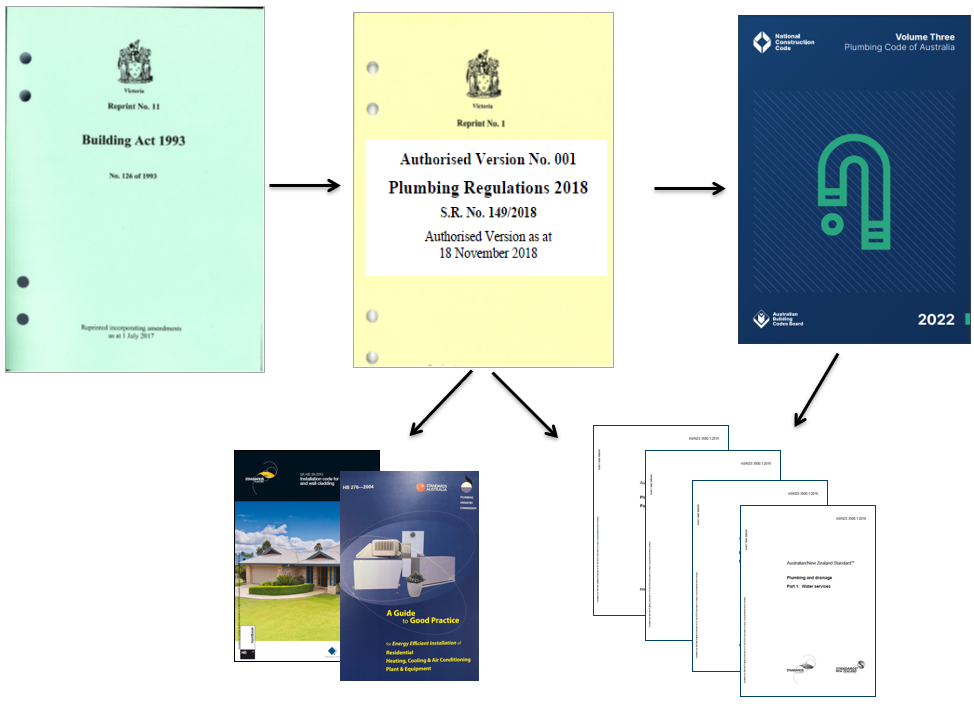Plumbing regulatory framework
The Victorian Building Authority (VBA) regulates Victoria's plumbing practitioners and plumbing work.
The three key documents which form the plumbing regulatory framework in Victoria are:
- Building Act 1993 (the Act)
- Plumbing Regulations 2018 (the Regulations)
- National Construction Code, Volume 3 (Plumbing Code of Australia, PCA).

Building Act 1993
The Building Act 1993 sets out the requirements for building and plumbing work in Victoria.
Part 12A of the Act sets out the legal framework for the regulation of plumbing work and plumbers. This includes:
- licensing and registration of plumbers
- restrictions concerning the carrying out of plumbing work
- compliance certificates
- inspection requirements for sanitary drainage work
- insurance orders
- rectification of defective plumbing work
- modification of plumbing regulations
- powers of the VBA’s enforcement staff (plumbing inspectors and compliance auditors)
- plumbing infringement notices
- plumbing inquiries and disciplinary action
- incorporation of the Plumbing Code of Australia into the regulations.
Plumbing Regulations 2018
The Plumbing Regulations 2018 commenced on 18 November 2018, replacing the Plumbing Regulations 2008.
The Regulations cover for the following aspects of plumbing work in Victoria:
- define the scope of work for all classes of plumbing work and specialised plumbing work
- set out the qualification and experience eligibility requirements for registration and licensing in each class of plumbing work and specialised plumbing work
- set fees payable for registration and licensing applications and the price of a compliance certificate
- set out additional technical requirements with which work performed in specified classes of plumbing must comply, including some variations from the requirements in the PCA.
Find out more about the Plumbing Regulations 2018 changes.
See also the Building and Construction Industry Security of Payment Regulations 2023.
National Construction Code – Plumbing Code of Australia
The National Construction Code (NCC) combines building and plumbing construction requirements into a single code.
The NCC is produced and maintained by the Australian Building Codes Board (ABCB), which is a joint initiative of federal, state and local governments (the Council of Australian Government, or COAG).
The NCC consists of the Building Code of Australia (Volumes One and Two) and the Plumbing Code of Australia (Volume Three).
- Volume One: relates primarily to Class 2 to 9 buildings.
- Volume Two: relates primarily to Class 1 and 10 buildings.
- Volume Three: relates primarily to plumbing and drainage associated with all classes of buildings. Also known as the Plumbing Code of Australia (PCA).
The PCA contains the technical requirements for the design and construction of plumbing and drainage systems in new and existing buildings. Volume 3 applies to all classes of buildings whenever plumbing work is carried out. The PCA also applies to sites where water services are constructed independent of buildings.
The NCC is updated and re-published every three years.
You can download the PCA at the Australian Building Codes Board website.
National Construction Code 2022
NCC 2022 was adopted by states and territories on 1 May 2023. Victoria has now formally introduced transitional arrangements for the following provisions:
- 1 May 2024 – New livable housing requirements.
- 1 May 2024 – Updated energy efficiency and condensation mitigation requirements.
New lead-free plumbing product requirements will commence on 1 May 2026.
The transitional arrangements will allow practitioners to continue using the relevant provisions of NCC 2019 until the end of the relevant transition period.
AS/NZS 4234: 2021 Transition Period
The Plumbing Regulatory Amendment 2022 confirms that the 2008 edition of AS/NZS 4234: Heated Water Systems - Calculation of energy consumption continue to be used.
The transition period for AS/NZS 4234: 2021 will now align with the transition period for new energy efficiency requirements proposed for NCC 2022 and will commence on 1 May 2024.
